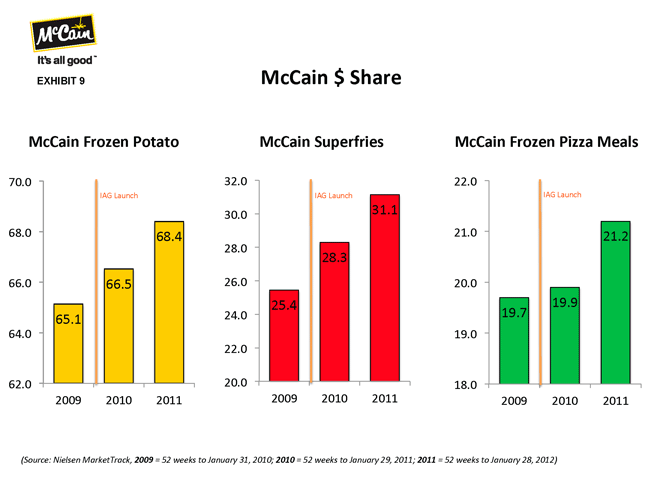It’s All Good – McCain
Sustained Success (BRONZE)
Client Credits: McCain Foods Canada
Fred Schaeffer: Regional CEO
Darryl Rowe: President, Canada
Heather Crees: VP Marketing
Bettie Lye: VP Research
Mike O’Brien: Brand Director, Potato & Appetizer
Paul Tralla: Brand Director, Potato (As of 2011)
Paul Gallagher: Brand Director, Pizza, Snacks & Desserts
Paul Kurvits: Brand Director, Strategy & Innovation
Irene Stathakos: Director of Marketing Insights
Kelly Switzer: Senior Brand Manager, Pizza
Elizabeth O’Neill: Brand Manager, Potato
Agency Credits: TAXI Canada
Maxine Thomas: VP Executive Strategic Director
Talke Krauskopf: Group Account Director
Kate Horne: Account Director
Nicole Libfeld: Account Manager
Darren Clarke: Executive Creative Director
Rose Sauquillo: Creative Director
Heather Hnatiuk: Creative Director
Irfan Khan: Creative Director
Maria Ward: Art Director
Sam Benson: Broadcast Producer
Eugene Marchio: Broadcast Producer
ADDITIONAL AGENCIES/PARTNERS
Anthem
AOR Media Management Inc.
Capital C
Veritas Communications Inc.
Crossover Notes:
All winning cases contain lessons that cross over from one case to another. David Rutherford has been identifying these as Crossover Notes since CASSIES 1997. The full set for CASSIES 2013 can be downloaded from the Case Library section at www.cassies.ca.
Crossover Note 6. Should the product be improved?
Crossover Note 11. The Eureka Insight.
Crossover Note 18. Keeping it Simple.
Crossover Note 19. Great minds think alike.
Crossover Note 32. Internal Marketing.
To see creative, click on the links that are embedded in the case.
Section I — BASIC INFORMATION
| Business Results Period (Consecutive Months): | January 2010 – January 2012 |
| Start of Advertising/Communication Effort: | January 13, 2010 |
| Base Period as a Benchmark: | January 2009 – December 2009 |
Section II — SITUATION ANALYSIS
a) Overall Assessment
We are what we eat. It’s an old adage, but one that moms in particular are thinking about more and more. Women who once bought convenient, processed foods and put them on the table without a second thought are beginning to wonder if that’s a good idea. In the last few years, a basic, everyday thing like food has become a hot topic. Concerns are emerging about the things we put into our food and what they might do to us in the long term. A new need has emerged: food that offers convenience without any of the concerns associated with it. [Crossover Note 19]
Three years ago, McCain, one of Canada’s most established frozen food companies, recognized the early stages of this societal shift and, in one of the biggest decisions in its history, made a commitment to change the way its Canadian products are made. [Crossover Note 6] This was dubbed the “McCain It’s all good™” initiative (IAG). The goal was very simple: the company would make its food the same way moms would if they were making it from scratch. Unrecognizable, unpronounceable ingredients were out; real ingredients were in, without compromising taste. The new products had to be equal to or better than the current ones and the competition’s. This was a huge undertaking. McCain had to fundamentally change the way their products were made. New recipes for over 70 products were developed, requiring intensive, groundbreaking product development, without taking shortcuts.
The communication challenge was to make consumers and stakeholders aware of these changes, to establish the importance of food being made exclusively with good ingredients, and to tackle the perception that frozen, processed food is unhealthy.
Based on the strategic platform we developed, and grounded in the insight that food should be the only ingredient in food, our campaign supported each pillar of McCain’s product portfolio. The effort was introduced at a corporate level, then rolled out into each product category, leveraging insights specific to the each category. The campaign used a media mix of traditional and digital, plus events and public relations.
From January 2010 to this day, the creative platform has enabled us to increase awareness of the IAG initiative, build the master brand attributes, drive sales, and grow share far beyond expectations.
b) Resulting Business Objectives
Business Objectives
Net Dollar Sales
Grow net annual sales of the McCain Frozen Potato, the McCain Superfries, and the McCain Frozen Pizza Meals segments versus the previous year and outgrow the category.
$ Share
Increase the $ Share for McCain Frozen Potatoes, McCain Superfries, and McCain Frozen Pizza Meals versus the previous year.
Unit Growth
Drive unit growth of McCain Superfries by +2% (Based on BASES Restager Research, conducted to extrapolate IAG impact in 2010).
Drive unit growth of McCain Frozen Pizza Meals of +7% (Based on BASES Restager Research, conducted to extrapolate the IAG impact in 2010).
Household Penetration
Increase household penetration for McCain Superfries and McCain Frozen Pizza Meals, and sustain it over time.
Perceptual Objectives
Create awareness of the McCain It’s all good™ brand promise.
Achieve a significant lift in McCain brand attributes for both the Pizza and the Potato business versus the benchmarks established in the 2009 brand tracking, such as:
• “McCain makes food that tastes great”
• “McCain uses quality ingredients”
• “McCain products are made with real, wholesome ingredients”
• “McCain is a brand for me”
Behavioural Objectives
Encourage consumers to question what is in their food and to make purchasing decisions based on this; in Year Two of the campaign, we incorporated social media to have true conversations with our consumers.
c) Annual Media Budget
Over $5 million
d) Geographic Area
National (Canada)
Section III — STRATEGIC THINKING
a) Analysis and Insight
Determining how to speak to transformational change required us to spend time focusing on the way moms typically think about the foods they serve their families, and more specifically about how these foods are made. Most moms rely, at least a few nights a week, on convenience food. With many moms working outside the home, the nights when dinner is made entirely from scratch are few. Many moms don’t have the time, energy, or inclination to scrutinize the ingredient lists of the foods they rely on. At the same time, mom hears that nagging little voice in her head, wondering if she’s doing the best thing for her family when she serves convenience food.
For years, none of these ingredients were challenged, and although technically safe, in terms of being approved by Health Canada, there’s something about sodium stearoyl lactylate and diglycerides that just doesn’t sound right. When we realized that no average consumer had these additives available for the meals they’d prepare on their own, the key product insight hit us: shouldn’t the only ingredient in food be, well, food? [Crossover Note 11]
This insight was rooted in the product story, so we needed to connect the product to the daily experience of our target. We did considerable exploratory research with moms to understand their thoughts and experiences of feeding and nurturing the family. Both new moms and veterans spoke to us about the question they faced every day – “What’s for dinner?” Arguably, this is the question moms hear more than any other.
Then an obvious irony struck us: if this question is being asked so much, why is no one asking, “What’s in dinner?” What exactly are the ingredients that go into the family’s food? This became the foundation of our entire campaign.
b) Communication Strategy
Leverage all available channels
While we relied heavily on paid advertising, we also used internal employee engagement [Crossover Note 32], PR, packaging, in-store communications, and McCain properties such as McCain.ca, McCain’s Facebook page, and the monthly newsletter.
Don’t lecture mom, help her
Knowing that moms already feel guilt we avoided anything that would make them feel more stressed. Anything that felt judgmental or lecturing was wrong. Instead, we took a more inquisitive approach.
Stage our communication into building blocks
In Year One we focused on introducing the core concept and telling our ingredient story. While many companies were making noise about a single offender, such as sodium or trans fat, we ensured that consumers understood that McCain was removing ALL unrecognizable ingredients, not just one or two. (Please see Exhibit 1: Example of Ingredient Comparison.)
In Year Two, while reinforcing the ingredient story, we expanded our campaign by supporting the emotional connection with the brand. We began to tell stories that reinforced McCain as a brand that allows mom to create the kinds of meals we all wish we had more of, where the food, the mood, and the conversation work for everyone. And everyone leaves the table with a smile!
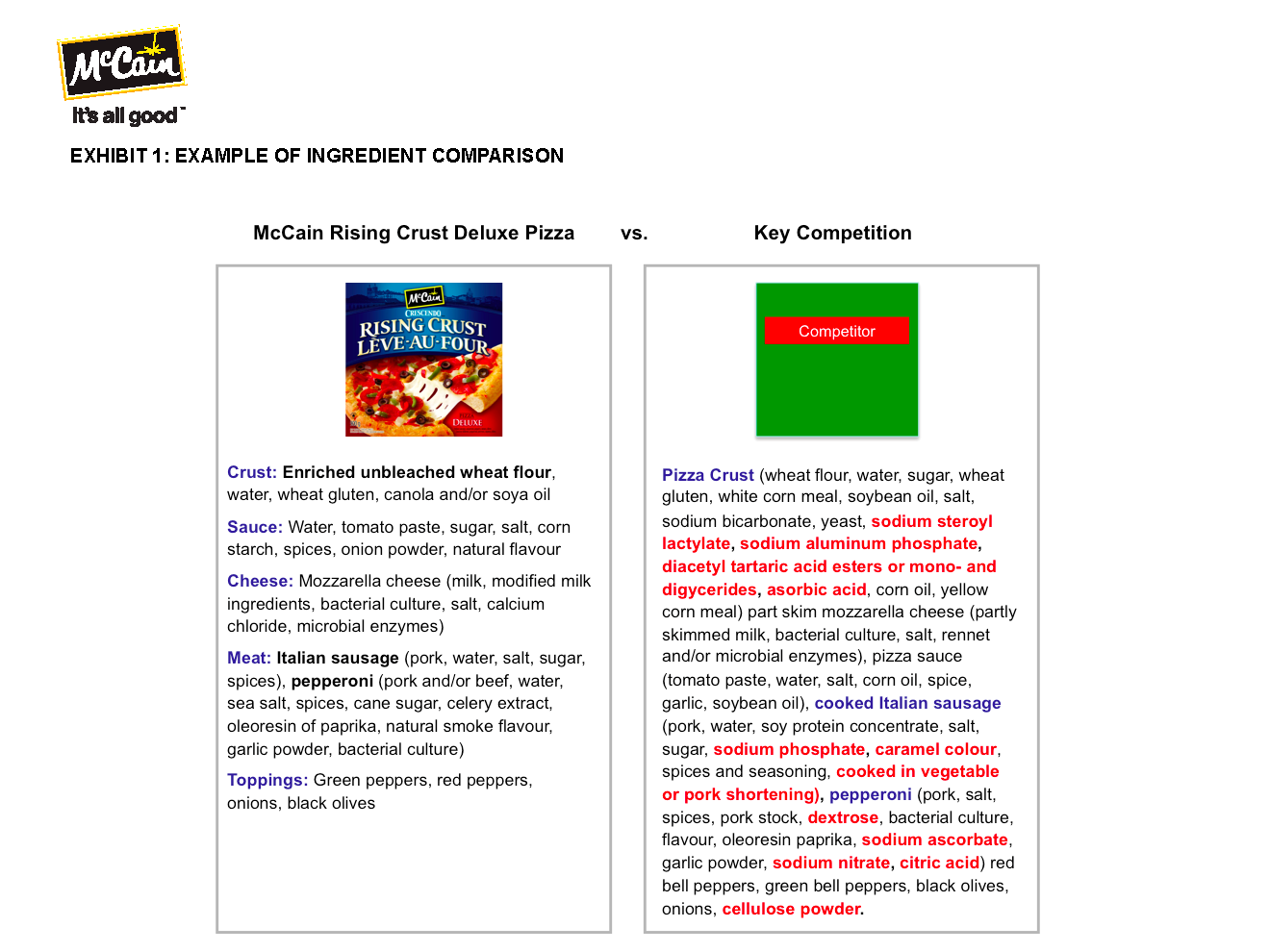
Section IV — KEY EXECUTIONAL ELEMENTS
a)Media Used
The McCain It’s all good™ campaign launched in the middle of January 2010. It was supported by television, print, PR, new packaging, a new website, and internal communications.
In Year Two we established our digital footprint through display advertising, rich media ads, page takeovers, and blogger partnerships, typically driving to the McCain Facebook page that launched in August 2011.
b)Creative Discussion
Perhaps because our strategy rested on a series of questions, our campaign idea followed a similar structure. Each component of the campaign began with a simple but provocative question about the food we feed our families. [Crossover Note 18]
TV
The launch spot asking ”What’s in dinner?” kicked off the campaign, while other spots had product-specific messages. In our pizza TV spot we asked, “Are all frozen pizzas made the same?” to encourage consumers to compare the ingredients. In our Superfries spot we asked, “What’s the difference between McCain Superfries and a potato?” to remind people that McCain’s French fries are made from the goodness of potatoes. These spots supported the corporate message and extended the IAG story to McCain products.
Print
This allowed us to feature additional products that didn’t receive dedicated TV support, like Pizza Pockets, asking, “Can a nutritionist and Pizza Pockets get along?”
The Website
McCain.ca was completely redesigned to match the new look and feel of the brand. We extended the questions we asked in TV and print, but the main purpose was to tell the in-depth story of McCain’s philosophy and to educate consumers about the products.
PR
PR aimed at government bodies, business and industry publications, family food experts, and food and lifestyle consumer publications. All consumer-directed PR challenged Canadians to start asking, “What’s in dinner?”
Packaging
New packaging designs were developed for over 70 product SKUs. McCain It’s all good™ is reflected in the packaging by two elements:
• Every package has fresh ingredients depicted with the McCain logo
• On the back, the ingredients are not just listed, as commonly seen on packaged goods; instead, a recipe card supports the idea of using wholesome ingredients like mom would if she was making it from scratch.
(Please see Exhibit 2 and Exhibit 3: Packaging)
2011
2011 saw many product innovations, like the McCain Ultra Thin Crust Pizzas, Vegetable Hashbrowns, Superfries Homestyle Red Skin Wedges, and Harvest Splendour Medleys. Some were supported through integrated multimedia communications, others with only TV.
Ultra Thin Crust Pizza
This was the most important pizza launch in 2011. The Thin Crust segment is growing, and McCain needed to disrupt Dr. Oetker’s monopoly. On TV we compared McCain’s pizza to Dr. Oetker’s. We showed what would be left of a Dr. Oetker pizza if it contained no artificial or simulated ingredients.
The Pizza Movie Promotion
In a highly competitive price-driven category, we offered consumers added value instead of a price reduction. We asked, “Can a pizza have all the right ingredients for a night of family bonding?” and then offered mom a fun evening for her family. She can feel great about the food she’ll serve and get a free movie download. For the price of a pizza, mom can arrange a fun night for the family.
The Frozen Potato Category Having to sustain the French Fries business in our Superfries TV spot, we asked the question, “Can McCain Superfries get any superer?” While kids already love them and attribute superpowers to them, we reassured mom that she can feel good about serving them.
However, the overarching goal for the Potato category in 2011 was to drive growth through the introduction of innovations. Supporting the launch of McCain Vegetable Hashbrowns, we built our campaign on the idea that everyone loves a great weekend breakfast, but no one wants to get up to make it. With McCain Superfries Homestyle Red Skin Wedges, we introduced a new side dish suited for different meals not typically associated with fries, like hamburgers and hotdogs, and that can easily compete with boring rice.
By asking “Should potatoes and other vegetables be mixed together?” we encouraged mom to break with her side-dish traditions and try new McCain Harvest Splendour Medleys. We used television as the vehicle to generate awareness for the product launch. We developed a strong digital-display plan, pushing to Facebook, where we asked Canadians if they were ready to break with tradition. We partnered with bloggers to sample and review the product, and we added a contest element on mom-specific sites as a promotional tactic to encourage more discussion and product trial with our target.
(Please see Exhibit 4: McCain Television Overview and Exhibit 5 to Exhibit 7: McCain Harvest Splendour Campaign)


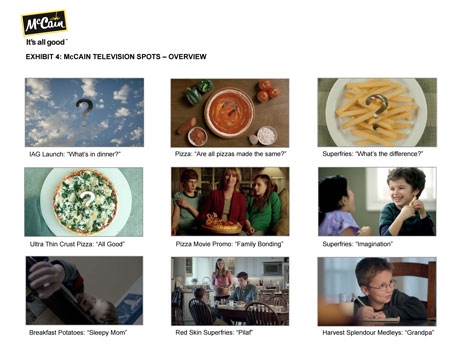

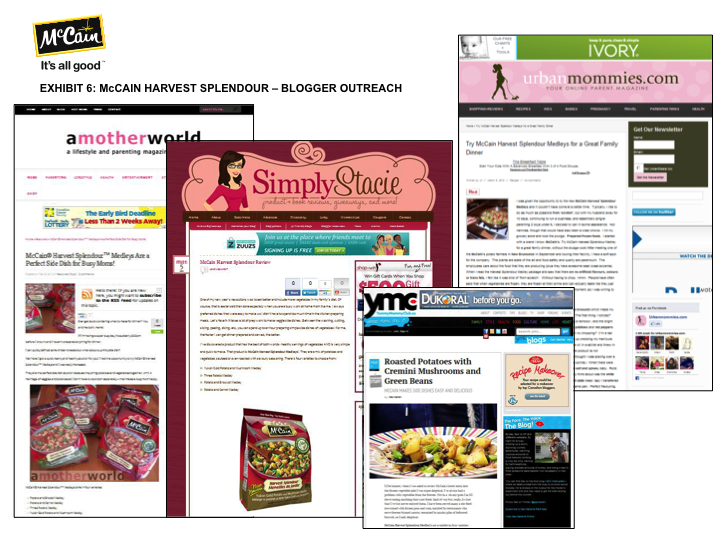
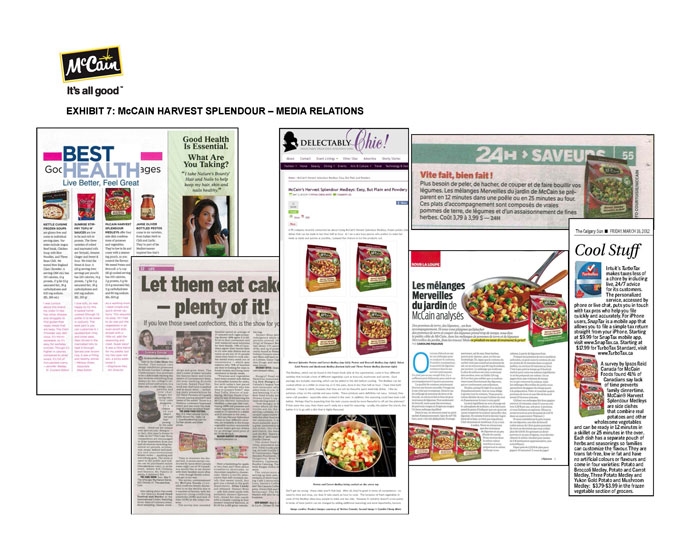
c)Media Discussion
A multichannel approach has been applied over the entire campaign.
After the PR-supported kickoff in the middle of January 2010, national TV and print advertising began at the end of January and McCain’s new website was launched. We used TV as our main medium on both conventional and specialty channels to drive awareness, along with a full-page magazine campaign in English and French Canada. Using the top Canadian, female-focused publications allowed us to reach a wide range of McCain’s top consumers multiple times.
While television still remained the key awareness driver, especially for new product launches, we developed a stronger online presence in Year Two. In mid-2011 we introduced the McCain Facebook page.
Section V — BUSINESS RESULTS
a) Sales/Share Results
Business Results (Please see Exhibit 8 to Exhibit 11)
Sales and unit growth across the key portfolios are up
• Net dollar sales for McCain Superfries increased by +11% in 2010 and +15% in 2011 and for McCain Frozen Pizza Meals by +4.1% in 2010 and +9.4% in 2011 (52 weeks vs. YA), each significantly outgrowing their categories every year. Growing the Frozen Potato category became a priority for 2011; with 7% growth in net dollar sales, McCain outpaced the category by +4%. (Source: Nielsen MarketTrack)
• Since the launch of IAG, McCain’s market dollar share has increased significantly in the mature Frozen Potatoes category (+3.3 points) and its subcategory, Frozen French Fries (+5.7 points), as well as in the highly competitive category of Frozen Pizza Meals (+1.5 points). (Source: Nielsen MarketTrack)
• Performance of McCain Superfries and Pizza has continued to exceed initial unit growth objectives of the BASES Restager. Since the launch of IAG, McCain Superfries have grown by +10% in 2010 and +8% in 2011; McCain Frozen Pizza Meals have increased by +12% in 2010 and +13% in 2011 (Unit Volume vs. YA). (Source: Nielsen MarketTrack)
• Since launch, the campaign drove a significant increase in household penetration in McCain’s key categories. With Frozen French Fries being a mature category with a bad reputation and the Frozen Pizza segment ruled by fierce competition, this is a major success. (Source: Nielsen Homescan)
Perceptual Results (Please see Exhibit 12 to Exhibit 14)
Millward Brown tracking shows a significant increase in awareness of the McCain It’s all good™ brand promise: +31% among pizza consumers and +39% among potato consumers. The success of the long-term campaign is shown by a positive impact on the consumer perception of the brand. Millward Brown tracking shows strong lifts in all relevant Master Brand attributes across the Potato and Pizza categories. (Source: Millward Brown Brand Tracking, November 2009 vs. 2011)
Behavioural Results
The campaign is proving to have an impact on what people base their purchasing decisions on.
• When exposed to the campaign message, 87% of consumers feel that the IAG initiative is relevant
• Awareness of McCain’s ad campaign makes consumers more likely to purchase McCain products, 77% (frozen pizza) and 75% (frozen potato), with the change to new ingredients
• 62% of consumers feel that the IAG initiative fits extremely or very well with the McCain brand
(Source: Vision Critical: McCain “It’s all good™” post-campaign study, April 2011)
McCain engaged directly in conversation with its consumers, and consumers were talking about the brand. From the launch of the Facebook page in August 2011 to the end of April 2012, McCain’s community has grown to 45,142 “likes”
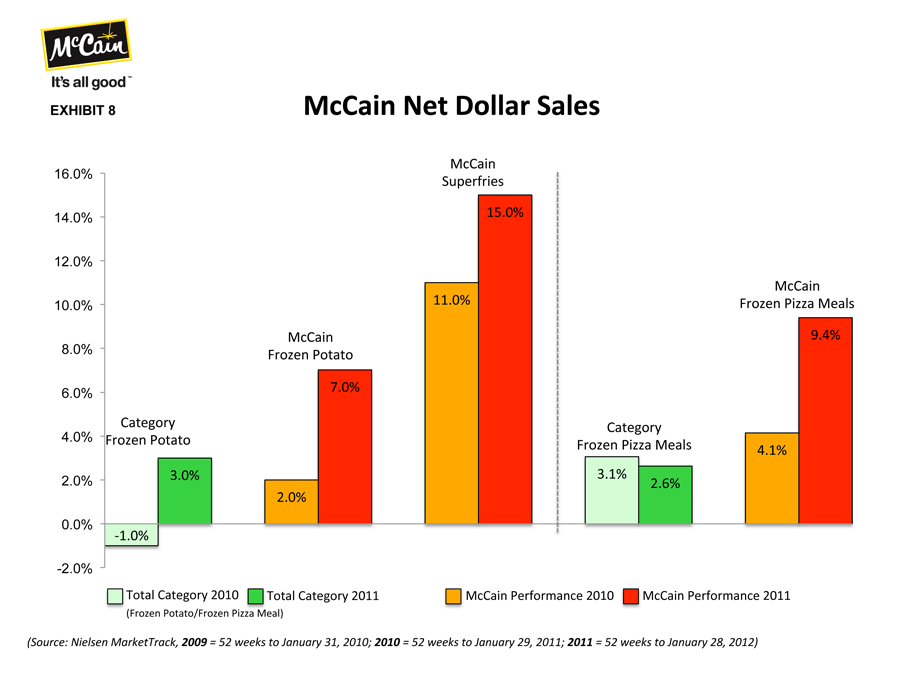
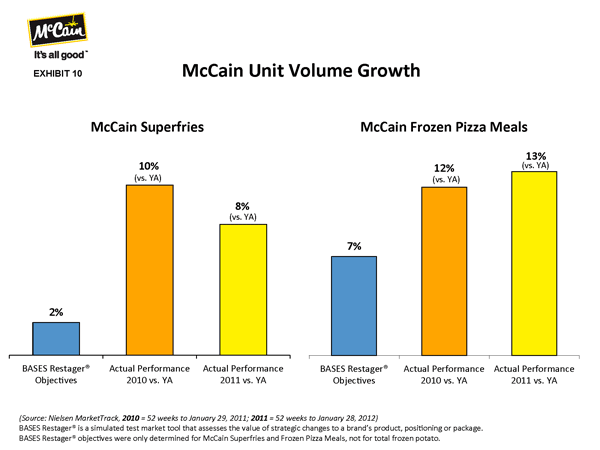
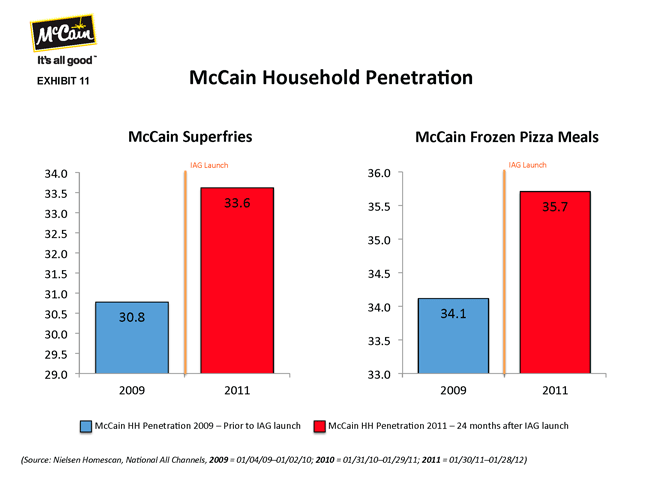
![]()
b) Consumption/ Usage Results
c) Other Pertinent Results
d) Return on Investment
Section VI — CAUSE & EFFECT BETWEEN ADVERTISING AND RESULTS
a)General Discussion
This was the first true integrated brand campaign in McCain’s history, and in Marketing magazine’s Marketing/Leger 2010 Corporate Reputation Survey, McCain jumped from 23rd to 13th place in one year – the biggest jump the survey had ever seen. With no other activities in-market, this can only be attributed to the McCain It’s all good™ campaign. In the 2011 survey, McCain was able to sustain its success, achieving 14th place in the ranking.
(Source: Marketing/Leger Corporate Reputation Survey, March 2010 and 2011)
b)Excluding Other Factors
Spending Levels:
(Please see Exhibit 15: McCain Television Spend Trending)
TV spending decreased in the year of the IAG launch vs. previous years by an average of 20%. Since the launch of the IAG campaign, the total media spend has remained flat at around $10 million (CAD).
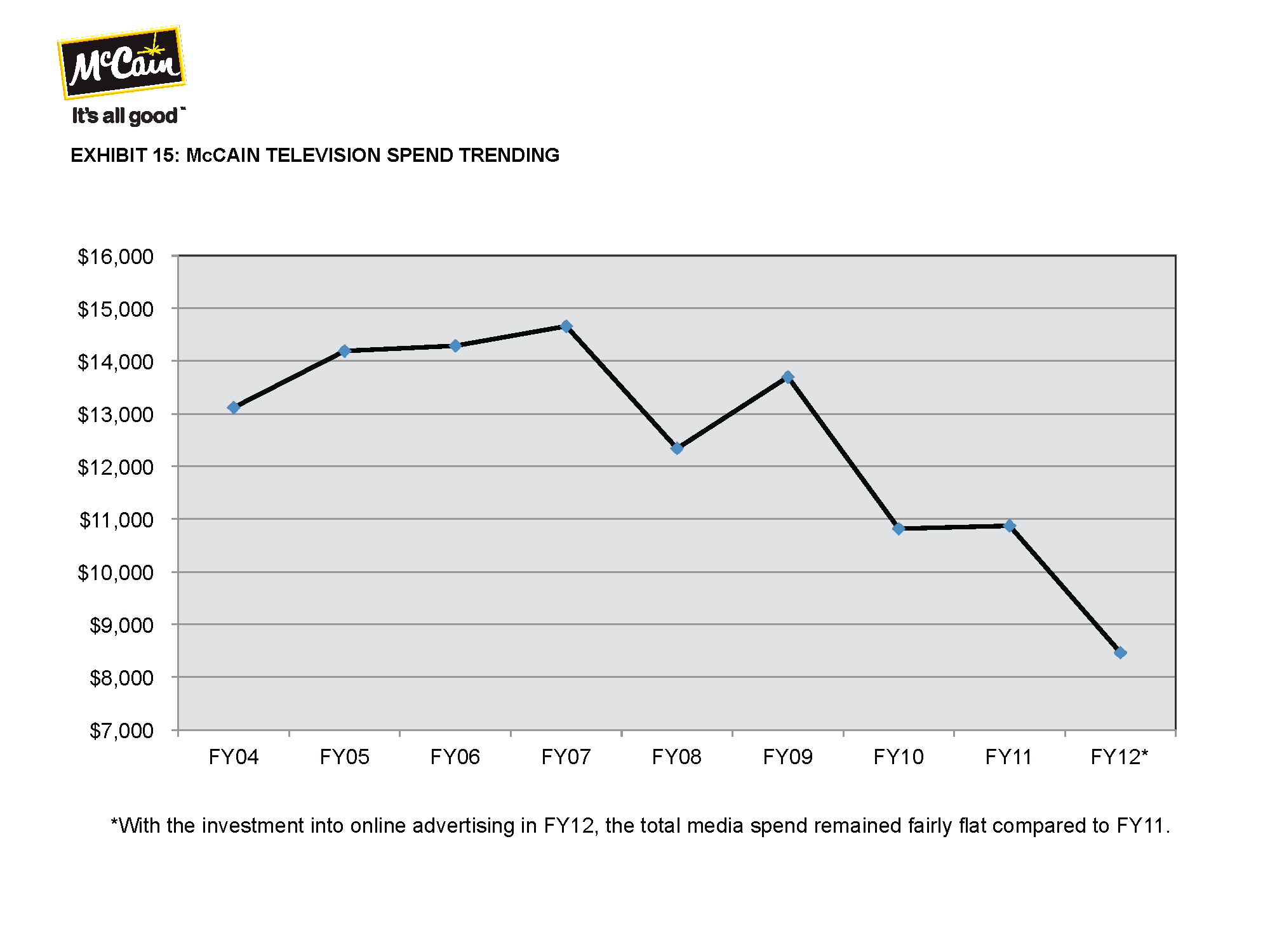
Pricing:
The prices of McCain Premium French Fries increased between June and September 2010. In the Pizza category, price promotion has always played a big role in the category and it did ramp up in recent years, but all competitors have participated equally, levelling the playing field. About 75–85% of all category sales occur on feature price, which was taken into consideration when setting the business objectives.
Distribution Changes:
No new distribution occurred during the campaign period. Some product SKUs were replaced by innovations.
Unusual Promotional Activity:
McCain’s promotional and trade activity maintained the same level of features as in previous years. There were no additional activities outside of the norm that could have been responsible for McCain’s success.
Other Potential Causes:
There are no other product, economic, or consumer factors during this period that could have positively affected sales.
